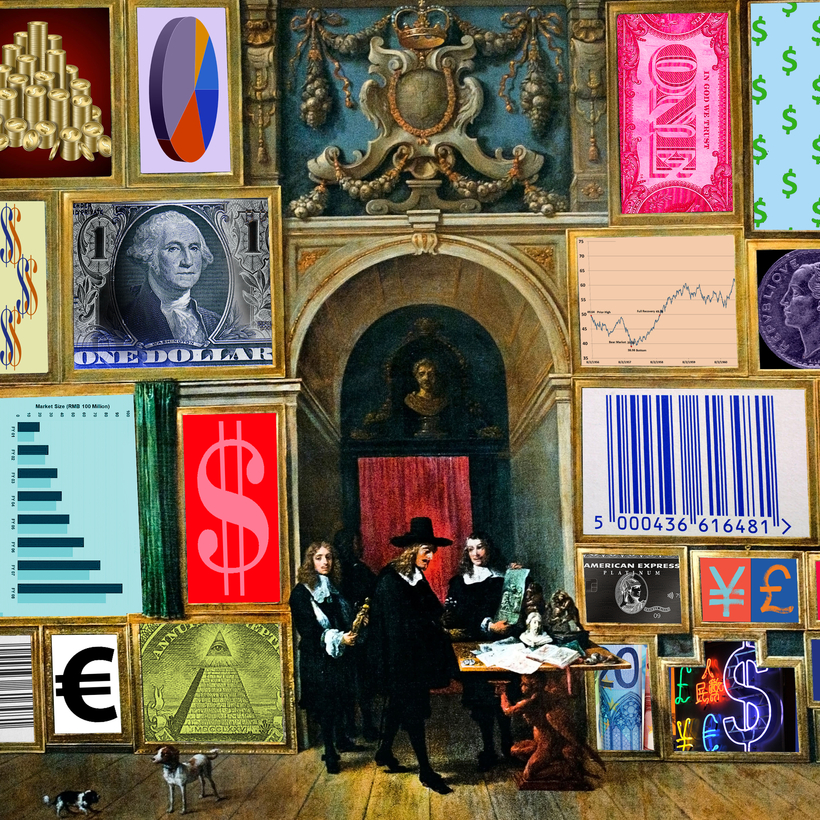It used to be that you’d buy art for the sake of enjoying it. There were the Medicis and Catherine the Great but also Gertrude Vanderbilt Whitney, Peggy Guggenheim, Gertrude Stein, and John and Dominique de Menil, people who acquired art because of the pleasure as well as the prestige of it. Oftentimes they knew the artists personally, and they surrounded themselves with their work.
Today there are still those collectors who buy art and keep it—even when they have an eye toward one day selling it, and even if they don’t know a whole lot about art, such as Steve Cohen or Jeff Bezos. For the most part, these high-net-worth individuals are staying close to their purchases. Then there are art dealers, who are a step removed from the artwork—their job is to flip it—but in this process, the art is often put on display for the general public. At least someone is seeing it, until it heads to auction again.
More recently, though, investment funds have entered the art space, widening the gap between touching and owning a work even further. The buying, holding, and selling model is being spread to its thinnest, inviting investors to have a hand in flipping art without ever even seeing it.
Masters of Disguise
An art start-up founded in 2017 by tech entrepreneur Scott Lynn, Masterworks offers art-industry outsiders a stake in the net worth of a not-quite-priceless painting. The company, founded in New York but registered with the S.E.C. in Delaware, buys works by big-name, top-selling artists—Jean-Michel Basquiat, Agnes Martin, Günther Uecker—at auction and private sales and makes ownership of the works, which the company claims they aim to hold for several years before selling, available to investors vetted by Masterworks’ sales team. Its art is stored at the Delaware Freeport.

Masterworks markets its model as one of high returns from art’s value outperforming the S&P. In reality, it’s based purely on faith on the part of its investors. In the more than two years since the company launched with a single work by Andy Warhol, a 1979 Marilyn Monroe print still in their inventory, only Banksy’s Mona Lisa has sold (for $1.5 million), at an annualized return to investors of 32 percent.
C.F.O. Nigel Glenday calls the sale “a terrific way for us to illustrate the proof of concept in the model,” even as he says it was unusual. Instead, Glenday says, “we feel like a 7-to-10-year hold is probably more typical across our investments,” decided on by a three-person board of managers that includes Lynn.
The price appreciation of similar works, based on historicized auction results, is used to anticipate the estimated return of any given work of art years into the future. It’s a long game for the finance nerd, and a serious disruption to the art-auction world.
Masterworks markets its model as one of high returns. In reality, it’s based purely on faith on the part of its investors.
Investment in Masterworks is not without its risks. The art-auction market prizes things that are “fresh,” meaning works that have not been sold in many years. It remains unclear whether the company’s 7-to-10-year holding period will cut it in the old-school world that art still inhabits. What’s more, the investment yields no earnings or dividends, and the business is, in its S.E.C. filings’ own words, “as undiversified as a company can possibly be.”
And, as is true for any work of art, the pieces acquired by Masterworks may unexpectedly decline in value, sell at a loss, or not sell at all—they are at the whim of an entirely irrational market.
Yet the company claims to have 100,000 investors. Outside of the fact that some 90 percent are American, little is publicly known about them.
Masterworks differs from the funds that came before it, such as the zipped-up, ultra-exclusive Fine Art Group in London, in the way that it markets itself. This isn’t just a way for the wealthy to invest 10 percent of their heaping portfolios, they say, though high-net-worth individuals are preferred; it’s also a way for ordinary people to turn modest sums into impressive ones—a Robinhood for the art market. For as little as $20 a pop, your investment is a fraction of an idea, a whisper of a hidden market. You neither own the work of art nor will you ever see it. (Unless you live near SoHo, in which case you can visit the Masterworks gallery, though even then, the artworks on show are only replicas of the real thing.) Whether or not you’ll see profits is still up in the air.
Nothing to See Here
Masterworks justifies its investors’ separation from the art they put money into by pointing to the very real free-port trend, which has been on the rise for years. What started off in the 1800s as neutral zones for storing goods in transport, such as grains, free ports have since evolved into luxury treasure troves which enable the rich to avoid paying taxes. The existing incentives for keeping valuable artworks stowed away in tax havens often mean they are kept private, even by collectors and museums.
Most famously, the $450 million acquisition of Leonardo da Vinci’s Salvator Mundi in 2017 was so discreet, no one seems to know where it is. Of course, the Salvator Mundi itself also began as an L.L.C., registered in Delaware. “There’s a lot of art that’s not hanging in people’s living rooms,” Glenday says.
Other loopholes favored by collectors include the establishment of charitable foundations in exchange for a massive tax break. Take Botticelli’s Portrait of a Young Man Holding a Roundel, which Sotheby’s sold to an unknown bidder for $92 million last month. The painting’s owner, the late billionaire real-estate tycoon Sheldon Solow, had consigned the work via the Solow Art and Architecture Foundation, a charitable organization he set up in 1991 presumably for the sole reason of taking advantage of the tax benefit.
In the years since its founding, during which it has collected works by Henri Matisse, Jean-Michel Basquiat, and Joan Miró, the Solow foundation has never made its collection at West 57th Street available to the public. On the Botticelli alone, Bloomberg estimates that Solow, who died late last year, saved his family $33 million in capital-gains taxes from the sale by gifting the masterpiece to his foundation beforehand. (Solow’s family now intends to open a public museum.)
“There’s a lot of art that’s not hanging in people’s living rooms.”
There’s a case to be made that the forces at play in the art market all but encourage art not to be seen. Masterworks just takes this a step further.
“We’re not an intra–art market business,” Glenday says. “We really address the need for investors who believe in the asset class, have conviction in the investment thesis, but have no interest in physical art ownership.” Glenday calls those who buy art to enjoy it “an extraordinarily tiny universe of people.” Even with investments into the hundreds of thousands, the company’s ideal investor is only looking for “exposure” and to incorporate art as “a portion of their overall portfolio.” They don’t care about seeing the art; they just want to skim the profits of owning it.
In the future, Masterworks plans to bundle its offerings, as its investors have expressed the desire not to be confined to a single painting. In other words, the company is looking for profits on the art market at large. The art itself is secondary.
Actually, it’s completely irrelevant.
Alexandra Bregman is a New York City–based writer


